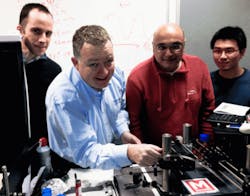University of St. Andrews and M Squared Lasers form partnership for biophotonics research
A new agreement between the University of St. Andrews (St. Andrews, Scotland) and M Squared Lasers (Glasgow, Scotland) is aimed at the development of a number of new photonics-related technologies with the potential to help in the detection and treatment of dire conditions such as cancer and Alzheimer's disease.
The newly signed IPR technology transfer agreement covers a broad portfolio of more than 100 patents, which researchers will use to develop commercial applications for the health sector. The suite of patents encompasses diverse biotechnology areas including microfluidics, particle fractionation and sorting, optical tweezing, cell poration, imaging, and Raman spectroscopic analysis techniques.
Biophotonics and the brain
"One key area we'll be exploring is the use of light-scattering (Raman) which can be used in the fight against cancer by accurately distinguishing between normal and unhealthy cells and tissue," says professor Kishan Dholakia at the University of St. Andrews. "In a similar way, Raman coupled with the use of fluorescence techniques may be used in the area of authentication of high-value liquors and spirits. More broadly, we'll be looking to unlock new information about how the human brain works. Through the use of advanced compact imaging platforms, which minimize damage through laser exposure, we hope to highlight cellular processes that could lead to an improved understanding of neural networks and conditions such as Alzheimer's disease. And while we're becoming more adept at developing lasers with higher specifications and quality, we still need to continually improve the way we characterize their performance, which is another area of research included in this suite of licensed technology."
Playing into a multibillion-dollar sector, the deal is projected to bring seven-figure returns to both the University of St. Andrews and M Squared Lasers over the period of commercialization of these technologies, according to M Squared Lasers.
"By focusing on practical applications for laser-based biophotonic products, we're aiming to develop new products with other companies in Scotland, the UK, and internationally," says Graeme Malcolm OBE, CEO of M Squared Lasers.
The biophotonics license agreement follows closely in the footsteps of three other such commercialization agreements between the University of St. Andrews and M Squared Lasers. Last year, the University of St. Andrews licensed its ultrafast laser and fast-pulse autocorrelation patents and further assigned its patent family of multiple strands of IPR in the areas of midinfrared optical parametric oscillator (mid-IR OPO) and terahertz technologies, which are used in the company's "Firefly" gas-imaging and security product ranges. The technology contained in the patents in the OPO and terahertz IPR portfolio arose from several University research projects undertaken over a 15-year period in the laboratories of professor Malcolm Dunn in the University's School of Physics and Astronomy and previously licensed to M Squared Lasers in early 2007.
Source: M Squared Lasers

John Wallace | Senior Technical Editor (1998-2022)
John Wallace was with Laser Focus World for nearly 25 years, retiring in late June 2022. He obtained a bachelor's degree in mechanical engineering and physics at Rutgers University and a master's in optical engineering at the University of Rochester. Before becoming an editor, John worked as an engineer at RCA, Exxon, Eastman Kodak, and GCA Corporation.
